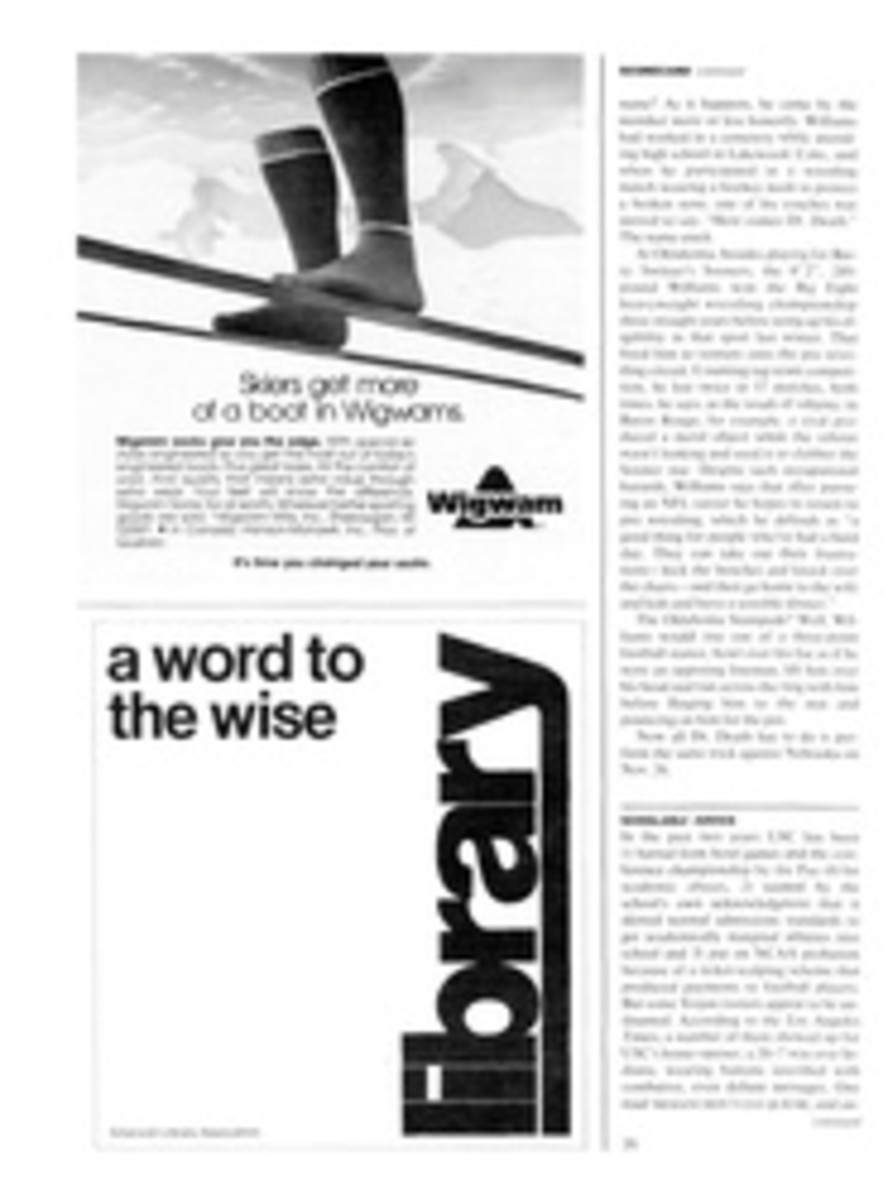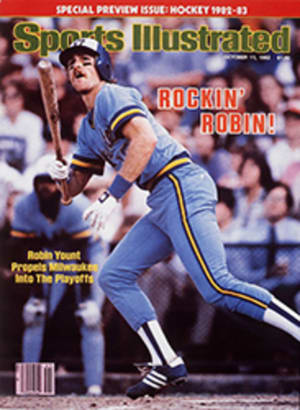
ONE SWEET SIOUX
Time was, if a kid harbored any hope of playing in the NHL, he almost had to come up through the Canadian junior system. Not anymore. Not only have European and U.S.-born players made well-documented inroads into the league but, somewhat more quietly, college hockey also has become a valued feeder system. Fifteen years ago the NHL had only five former collegians on its rosters. Last season 91 played. In June's amateur draft alone, 20 collegians were selected, and another 20 players in last season's NCAA championship game between North Dakota and Wisconsin had already been drafted by NHL clubs.
Before the awakening, top Canadian players were a tough target for college recruiters. One college coach remembers trying to entice a youngster to his school by telling the boy's father that his son had the potential to become an All-America. "Oh, no," said Dad. "I want my boy always to remain Canadian." Those days are gone. Canadian prospects are aware of the attention pro scouts pay U.S. colleges (more than 25% of the games the NHL's Central Scouting staff watches every season are in the U.S.). They also see college games on TV (North Dakota's, for instance, are televised as far north as Saskatoon). "As more players come into the league from the colleges," says Islander General Manager Bill Torrey, "more kids are saying, 'I can have the best of both worlds. I can get an education and play good enough hockey to become a pro.' " Because Canadian colleges offer few athletic scholarships, the players head south.
A lot of them come to the University of New Hampshire, where Coach Charlie Holt has turned out eight NHL pros in his 14 years in Manchester. Seven were in the league last season. Three-time NCAA champion Boston University also has had its share, as have Clarkson, Boston College and other Eastern College Athletic Conference schools. Nevertheless, hockey isn't as strong in the East as it is in the North Central region of the country, which in the college game is referred to as the West. Minnesota alone had 14 players in the NHL in 1981-82, and the five other Western Collegiate Hockey Association members—North Dakota, Wisconsin, Denver, Colorado College and Minnesota-Duluth—contributed a total of 23. Another 16 came from the four schools that left the WCHA in 1981 to join the Central Collegiate Hockey Association—Michigan, Michigan State, Michigan Tech and Notre Dame.
Western schools have long dominated the college game, winning 28 of 35 NCAA titles. The season starts nearly a month earlier in the West (this week for 17 schools) than in the East and involves more games (35 to 40 vs. 20 to 25). In addition, Western hockey is, by reputation, rougher, which helps attract NHL aspirants, and recruiting is more aggressive than at Eastern schools. One-third of the Division I teams in the East belong to the Ivy League, in which financial aid is based on need. "We operate on need, too," says North Dakota Coach Gino Gasparini with a smile. "We need a goaltender. We need a defenseman."
When asked to rank the teams nationally, only one of the 35 college coaches polled by SI rated an Eastern school No. 1. That was perennial powerhouse Clarkson. Minnesota has seven NHL draftees among its eight blue-chip freshmen, and Michigan State is led by the best goalie in the country, Ron Scott. Come March, however, when defending champion North Dakota hosts the NCAAs, chances are the Fighting Sioux will be the team to beat. North Dakota has the best coach in Gasparini (now that Bob Johnson has gone to the NHL) and, in James Patrick, a sophomore defenseman, perhaps the best player.
Two years ago Patrick was selected as the best junior Tier II player in Canada, and last season he was Freshman of the Year in the WCHA. Drafted No. 1 by the Rangers in 1981, he is the only first-round pick ever to put off the pros for college. In fact, Patrick is so good—and so fortunate—that he has a tough time remembering what it was like to play on a losing hockey team. "When I was 12 our team was one of the worst in the league," says Patrick, who's now 19. "At that age, you're busy just playing and having fun. But you still hate to lose. I sure did."
Thousands of young athletes learn to hate losing, but few experience defeat as rarely as Patrick has. Not since he was 13 has a hockey team he has played for failed to win the biggest prize available. After leading Bantam and Minor Midget teams in his native Winnipeg to Western Canada and provincial championships in 1978 and 1979, respectively, Patrick entered Notre Dame College, a boarding school in tiny Wilcox, Saskatchewan with a marvelous hockey tradition and a fine academic reputation. The Hounds finished with a 67-2-1 record and won the national Midget title in 1980. The following year, eschewing junior Tier I hockey to keep his college eligibility, Patrick played for the Prince Albert (Sask.) Raiders, a Tier II team. They, too, won the national championship, going 57-7-1.
Last season, despite being a No. 1 draft choice and the ninth pick overall, Patrick matriculated at North Dakota. He had five goals and 24 assists as the Fighting Sioux went 35-12 to win their second NCAA championship in three years. Patrick was the only freshman named to the all-tournament team. Three months earlier, during Christmas break, he had played on the Canadian team that won the Junior Worlds, in Minneapolis. "Up to now, every decision James has made has been perfect," says his father, Steve, a real estate man who was a CFL All-Pro lineman for the Winnipeg Blue Bombers under Bud Grant and a member of the Manitoba Parliament in 1962-77.
While he could stand to beef up his 6'2", 192-pound frame, Patrick has what it takes to be a Ranger right now. His defensive partner at Notre Dame and in the Junior Worlds, Gord Kluzak, was the No. 1 pick in the entire NHL draft this year. Barry MacKenzie, who coached them both at Notre Dame, says Patrick was the better player, albeit partly because he is 10 months older.
Why, then, will Patrick be attending an 11 a.m. economics class this fall while Kluzak skates with the Boston Bruins? "I want to experience university life," Patrick says. "Plenty of guys are 18 and in the NHL, but they're missing a lot. Sure, they make lots of money, but a lot of them sign and then end up in the minors, teed off."
Witness Patrick's older brother, Steve, 21, who turned down a scholarship at North Dakota to play for Brandon, Manitoba, one of the top Canadian junior teams, because he was told the move would propel him directly into the NHL. Sure enough, the Buffalo Sabres made Steve their first pick in 1980, but since then he has been shuttled among Buffalo, Brandon and Rochester of the American Hockey League. "Right now, Steve says if he had it to do over again, he would go to college," says James.
Grand Forks, the original home of Cream of Wheat and one of the few places in the world that have legalized gambling with a $2 maximum (in casinos and hotel lounges), is a grand place to play college hockey. As the only Division I sport in the state, hockey outdraws every other sport at the school. Gasparini, who became coach four years ago, teaches a rough brand of hockey, emphasizing defense, and Patrick practices what the coach preaches. "James has extreme quickness and a tremendous knowledge of the game," says Gasparini. "He can make a play in open ice, and when there's a lot of traffic, as well."
"I can handle the puck and skate with it good," says Patrick, "but that shouldn't take away from my defensive play. At the Junior Worlds, Gord and I had only one goal scored on us in seven games."
"At first, people couldn't figure out why he was drafted in the first round," says Goalie Darren Jensen. "Some said, 'Maybe we've been gypped. This guy isn't so great.' But he does everything to a T. He makes it look so easy."
Sometimes Patrick doesn't even have to show up to be recognized. For finishing second in the RPI Invitational, which was held during the Christmas holidays while Patrick was at the Junior Worlds, the Sioux were given a wristwatch. One watch for the whole team. Gasparini let the players decide what to do with it. By season's end, they had: It went to the player with the best plus-minus total—Patrick.
Evidently, they hadn't been gypped.
[originallink:10621301:43619]
TWO PHOTOS
After leading North Dakota to the national title, Patrick could have joined the Rangers, but he decided instead to keep hitting the books.
TOP 10 | 1981-82 RECORD |
North Dakota | 35-12-0 |
Minnesota | 22-12-2 |
Michigan State | 26-14-2 |
Clarkson | 26-8-1 |
Wisconsin | 35-11-1 |
Bowling Green | 27-13-2 |
New Hampshire | 22-14-0 |
Michigan Tech | 23-14-3 |
Denver | 19-19-3 |
Providence | 19-12-0 |

